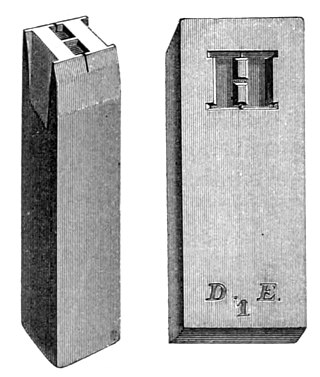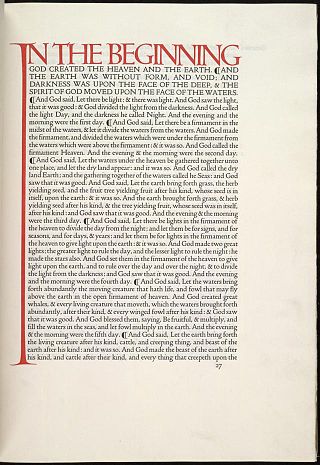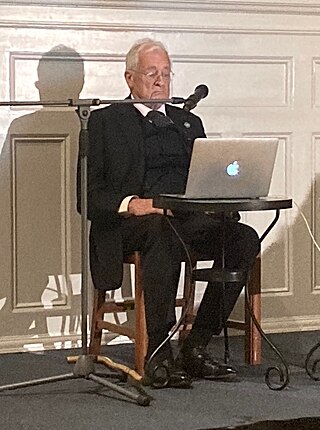
Frederic William Goudy was an American printer, artist and type designer whose typefaces include Copperplate Gothic, Goudy Old Style and Kennerley. He was one of the most prolific of American type designers and his self-named type continues to be one of the most popular in America.

Thomas James Cobden-Sanderson was an English artist and bookbinder associated with the Arts and Crafts movement.
Private press publishing, with respect to books, is an endeavor performed by craft-based expert or aspiring artisans, either amateur or professional, who, among other things, print and build books, typically by hand, with emphasis on design, graphics, layout, fine printing, binding, covers, paper, stitching, and the like.

The Kelmscott Press, founded by William Morris and Emery Walker, published 53 books in 66 volumes between 1891 and 1898. Each book was designed and ornamented by Morris and printed by hand in limited editions of around 300. Many books were illustrated by Edward Burne-Jones. Kelmscott Press books sought to replicate the style of 15th-century printing and were part of the Gothic revival movement. Kelmscott Press started the contemporary fine press movement, which focuses on the craft and design of bookmaking, often using hand presses. While their most famous books are richly decorated, most Kelmscott Press books did not have elaborate decoration, but were published simply.

Punchcutting is a craft used in traditional typography to cut letter punches in steel as the first stage of making metal type. Steel punches in the shape of the letter would be used to stamp matrices into copper, which were locked into a mould shape to cast type. Cutting punches and casting type was the first step of traditional typesetting. The cutting of letter punches was a highly skilled craft requiring much patience and practice. Often the designer of the type would not be personally involved in the cutting.

The Ashendene Press was a small private press founded by St John Hornby (1867–1946). It operated from 1895 to 1915 in Chelsea, London and was revived after the war in 1920. The press closed in 1935. Its peers included the Kelmscott Press and the Doves Press. Hornby became friends with William Morris and Emery Walker, who helped inspire his work. These three presses were part of a "revival of fine printing" that focused on treating bookmaking as fine art. The Ashendene Press was famous for producing high-quality works by Dante. Ashendene books had excellent bindings and focused more on pleasure than reform than the other private presses of the time, though one review claims that the Ashendene Press was the most successful private press in recapturing the essence of fifteenth-century printing. Ashendene books were carefully printed with large margins, and despite their lack of extravagant decoration, they were considered spectacular works of art. Two original typefaces were created for the Ashendene Press: Subiaco and Ptolemy. They were known for handwritten, colored initials by Graily Hewitt. The press' main customers were book collectors who paid for a subscription for Ashendene books.

The Doves Press was a private press based in Hammersmith, London. During nearly seventeen years of operation, Doves Press produced notable examples of twentieth-century typography. A distinguishing feature of its books was a specially-devised typeface, known variously as Doves Roman, Doves Press Fount of Type, or simply Doves Type.
John Waynflete Carter was an English writer, diplomat, bibliographer, book-collector, antiquarian bookseller and president of the Bibliographical Society in 1968. He was recognised as one of the most important figures in the Anglo-American book world. He was the great-grandson of Canon T. T. Carter
Fine press printing and publishing comprises historical and contemporary printers and publishers publishing books and other printed matter of exceptional intrinsic quality and artistic taste, including both commercial and private presses.
Porson is an influential typeface in the Greek alphabet based on the handwriting of the English classicist Richard Porson.
The Rampant Lions Press was a fine letterpress printing firm in Britain, operating from 1924 to 2008. The firm was founded by Will Carter, publishing its first book in 1936, and was continued by his son, Sebastian Carter, from 1966.
Colin Ellis Franklin, FSA was an English writer, bibliographer, book-collector and antiquarian bookseller.

Thomas Maitland Cleland was an American book designer, painter, illustrator, and type designer.

7 Hammersmith Terrace is an historic house in the London borough of Hammersmith and Fulham, England, and the former home of English engraver and printer Emery Walker. Walker was an important figure in the English Arts and Crafts movement, and a close friend of textile designer William Morris, who lived nearby. During his life, Walker furnished the home in an Arts and Crafts style, reflecting his friendships with Morris and others.

Julia Sarah Anne Cobden-Sanderson was an English socialist, suffragette and vegetarian.
Oak Knoll is a bookseller and publisher based in New Castle, Delaware, United States. Oak Knoll includes Oak Knoll Books which specializes in the sale of rare and antiquarian books and Oak Knoll Press which is a publisher and distributor of in-print titles. Both divisions specialize in "books about books" on topics such as printing history, bibliography, and book arts. Oak Knoll has also been the sponsor of the book arts festival Oak Knoll Fest.

The Golden Type is a serif typeface designed by artist William Morris for his fine book printing project, the Kelmscott Press, in 1890. It is an "old-style" serif face, based on type designed by engraver and printer Nicolas Jenson in Venice around 1470. It is named for the Golden Legend, which was intended to be the first book printed using it. The original design has neither an italic nor a bold weight, as neither of these existed in Jenson's time.

Edward Philip Prince (1846–1923) was a British engraver and punchcutter, a cutter of the punches used to stamp the matrices used to cast metal type.
The Sandars Readership in Bibliography is an annual lecture series given at Cambridge University. Instituted in 1895 at the behest of Samuel Sandars of Trinity College (1837–1894), who left a £2000 bequest to the University, the series has continued to the present day. Together with the Panizzi Lectures at the British Library and the Lyell Lectures at Oxford University, it is considered one of the major British bibliographical lecture series.

Nicolas John Barker is a British historian of printing and books. He was Head of Conservation at the British Library from 1976 to 1992.












